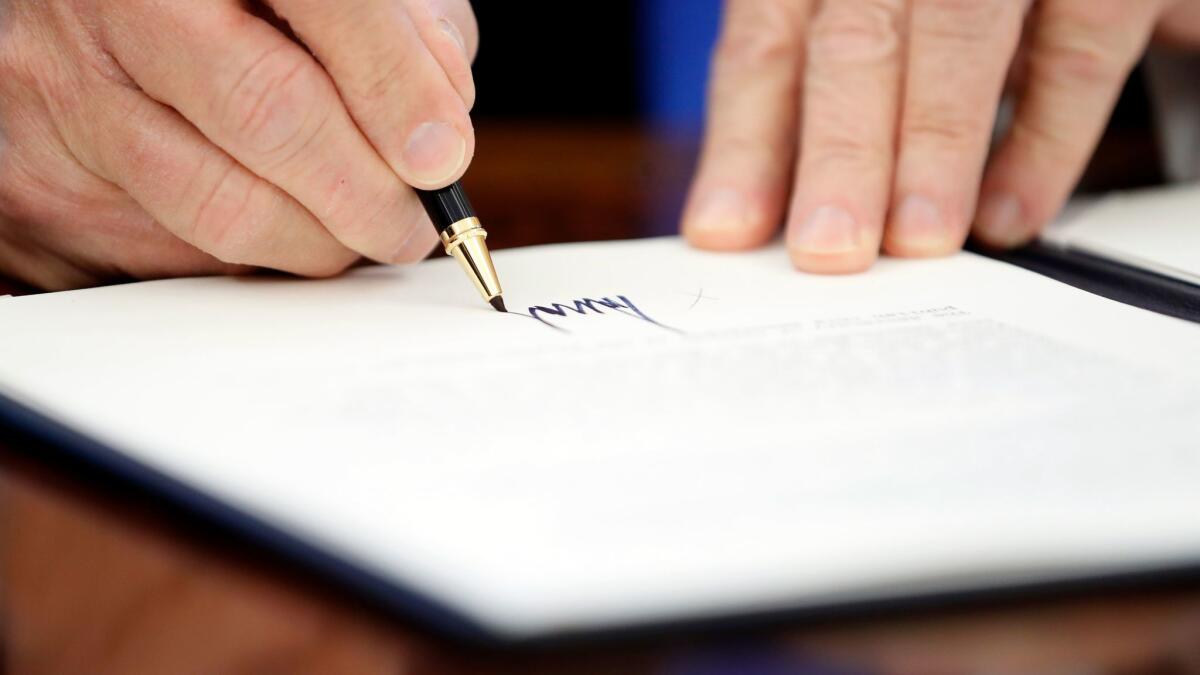Presidents since George Washington have been signing executive orders. How do Trump’s stack up?

Since the days of George Washington, U.S. presidents have been issuing executive orders that do not require the assent of Congress.
Rarely, however, do they elicit the kind of outcry and legal pushback from opponents that have marked President Trump’s first weeks in office.
Although the number of orders signed has left some observers breathless, such a flurry is not unusual in the opening weeks of a new administration. But the edicts don’t usually have the immediate impact of Trump’s order suspending refugee resettlement and temporarily blocking travel from seven majority-Muslim countries.
There also is the political context to consider: “He is just way more controversial as a political figure than anybody I can remember,” said John Woolley, who co-directs the American Presidency Project at UC Santa Barbara.
“With Donald Trump, you’ve got a guy who lost the popular vote. He has less public approval than any incoming, brand-new president that we have records for. And Democrats have been watching how Republicans fought Barack Obama,” he said.
So a pushback was perhaps to be expected. It will be up to the courts to decide whether Trump has overstepped his authority.
Here is a look at how Trump’s executive actions stack up against those of his predecessors:
What are executive orders?
Executive orders are one of a variety of written instruments presidents can use to exercise their authority. They typically contain instructions to federal agencies that presidents oversee on how they should discharge their responsibilities.
Although such orders are often viewed as carrying more legal weight than other kinds of presidential directives, experts say there is no substantive difference between them. As long as the directives conform to the Constitution and statutes, they carry the force of the law, but can be revoked by a future president with the stroke of a pen.
The exact number of these documents is not known, though estimates range into the tens of thousands. A requirement to number and publish executive orders and proclamations dates only to 1936 and does not apply to documents without “general applicability and legal effect.”
Are executive orders always this controversial?
Many executive orders are fairly mundane. George W. Bush’s orders included instructions to his secretary of Health and Human Services to develop a national program to enhance physical activity and participation in sports. He also made adjustments to the pay scale and order of succession in government agencies.
But presidents also have used executive actions to make sweeping changes in national policy, whether in times of war or to get around an uncooperative Congress.
Some notable examples include:
- Abraham Lincoln’s 1862 Emancipation Proclamation, which declared slaves free in rebel states during the Civil War.
- Franklin D. Roosevelt’s 1942 order authorizing the internment of Japanese Americans during World War II.
- Harry S. Truman’s 1948 order to integrate the armed forces.
How do Trump’s orders compare to those of his predecessors?
In terms of quantity, the new president’s orders are not that different from other recent commanders-in-chief.
Barack Obama signed nine executive orders during his first two weeks in office in 2009, including ones to close the Guantanamo Bay detention camp within a year, shut down the CIA’s network of secret overseas prisons and end the agency’s use of interrogation techniques that critics describe as torture.
Trump has issued eight executive orders. In addition to the travel ban, they include instructions to begin construction of an expanded border wall with Mexico and threats to withhold federal funding from so-called sanctuary cities, such as Los Angeles and San Francisco.
The president who signed the most executive orders is Roosevelt, who put his name to 3,721, according to a count by the American Presidency Project. His longevity in office — three full terms and his election for a fourth — isn’t the only reason for the unusually high total. He averaged 307 executive orders a year, more than any U.S. leader before or since.
The only U.S. president who didn’t issue any executive orders was William Henry Harrison. Within weeks of his inauguration in 1841, he caught a cold that developed into pneumonia and died on his 32nd day in office.
Even James A. Garfield, who served as president for only 200 days, issued six executive orders before he was assassinated in 1881.
The number of executive orders signed during a presidency has declined markedly since the end of Roosevelt’s administration.
But numbers don’t tell the whole story, Woolley said.
More recent orders have tended to include a greater proportion of “substantively important” actions than was the case in earlier decades, in part because of legal changes that shifted responsibilities away from the president to other parts of the government. For example, other members of the executive branch now can issue orders concerning public lands that once needed the action of the president.
“What matters is whether the president and the executive branch are behaving in ways that are hugely controversial,” Woolley said, either because of what their orders say or because “the president’s authority to take the action is dubious.”
Obama’s 276 executive orders may pale in comparison to previous presidents. But the figure does not include some of the most contentious actions taken by his administration — including immigration reforms that offered deportation relief and work permits to people who were brought to the U.S. as children and stayed illegally.
What limitations are there?
Only Congress can change laws or appropriate new funds from the Treasury. Presidents are required to uphold those laws and work with the resources they are given.
When presidents overstep these limits — which aren’t always precisely defined — they can be blocked by the courts.
Already, a handful of federal judges have issued rulings blocking key aspects of Trump’s travel ban.
More lawsuits are in the works. On Tuesday, San Francisco became the first U.S. city to challenge the order putting cities and counties on notice that they will lose federal funding if their law enforcement officials don’t start cooperating with immigration agents.
Members of Congress also have tools they can use to block presidential orders, including passing laws or refusing to fund aspects they don’t like.
And in four years, voters can elect a new president who will have the authority to revoke his predecessor’s orders.
Twitter: @alexzavis
ALSO
Trump’s first week: For many in Arizona, it doesn’t get any better than this
No surprise: Way more Californians dislike Trump’s immigration orders
Protests, firings and hirings: All the major events of Trump’s second week as president
UPDATES:
4:35 p.m.: This article was updated with Trump issuing an eighth executive order.
This article was originally published at 10:40 a.m.
More to Read
Sign up for Essential California
The most important California stories and recommendations in your inbox every morning.
You may occasionally receive promotional content from the Los Angeles Times.











